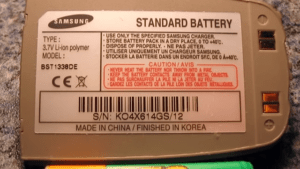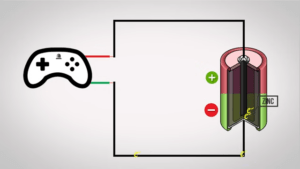
How These Batteries Work
Let’s take a peek under the hood and explore what’s happening inside each type of battery. Diving into the technical realm, we’ll uncover how each battery brings your gadgets and projects to life.
NiMH Batteries: Simple and Familiar
Yes, NiMH batteries can be a bit like old friends. They consist of a collection of rechargeable elements – hydrogen and metal hydrides. During discharge, these elements generate electricity for us, and then during charging, they return it back into the battery. The process is somewhat like a continuous cycle of topping up and draining that powers your devices.
Lithium Batteries: Compact Energy Powerhouses
Now, lithium is a true energy athlete. Li-Ion and LiPo batteries contain lithium, which can store and release energy in abundance. Inside the battery, there’s an anode (minus) and a cathode (plus), surrounded by an electrolyte. During discharge, lithium moves from the anode to the cathode, giving us electricity. Then, during charging, lithium returns back to the anode, ready for the next energy boost.
Summing Up: Balancing Energy and Safety
So, what’s the takeaway? NiMH batteries are like a bunch of little friends, each ready to lend a hand. They’re simple and reliable. On the other hand, lithium batteries are like energy powerhouses. They can store more energy than standard batteries and deliver it to your beloved gadgets. But here’s the catch: lithium batteries require caution and extra safety measures.
So, you see, it’s not just a “plug and forget” scenario. Understanding how these batteries work will help you make an informed choice that suits your project. And now that you’ve unlocked the world of batteries, you’re all set to move forward and create your portable masterpieces!

Making Your Gadgets Go Boom Boom with Batteries
So, you know when you’re all excited about a new project with your gadgets, and you’re like, “Hmm, which battery should I use?” Well, that’s where things get interesting. The kind of battery you pick can totally change how well your project works, how long it runs, and how safe it is. In this little adventure, we’re going to dive deep into the world of batteries and check out two cool types: Nickel Metal Hydride (NiMH) and Lithium batteries (the fancy ones are Lithium-Ion or Li-Ion and Lithium Polymer or LiPo). Each has its own bag of tricks and things you gotta keep in mind.
Where You’ll Find Them: Battery Types in Gadgets
Now that we’ve got the lowdown on NiMH and lithium batteries, let’s dive into where these batteries really shine. These power sources find their homes in a wide array of gadgets, each serving a unique purpose.
NiMH Batteries
- Remote Controls: Ever wondered how your TV remote keeps going? NiMH batteries are the unsung heroes, providing the juice for endless channel surfing and Netflix marathons.
- Flashlights: When the lights go out, NiMH batteries are there to save the day. From camping trips to emergency situations, they power up those trusty flashlights.
- Cordless Phones: Say goodbye to tangled cords. NiMH batteries are the driving force behind cordless phone conversations that keep you connected without the mess.
- Toys and Games: Kids’ playtime wouldn’t be the same without NiMH batteries. From remote-controlled cars to handheld gaming consoles, they fuel hours of entertainment.
Lithium Batteries
- Smartphones: Your pocket-sized assistant thrives on lithium power. Li-Ion and LiPo batteries ensure your calls, texts, and selfies keep rolling.
- Laptops: When you’re typing away on your laptop, remember that lithium batteries are working behind the scenes, providing the energy for your work and play.
- Drones: Those breathtaking aerial shots? You can thank lithium batteries for keeping drones soaring and capturing stunning footage.
- Portable Speakers: Pumping out your favorite tunes is all thanks to lithium batteries. They make sure the music keeps flowing during picnics and parties.
The Battery Showdown
It’s not a matter of one battery type being better than the other; they each have their moments to shine. Whether it’s powering your TV remote or keeping your laptop alive during a marathon work session, both NiMH and lithium batteries have carved out their niches in the world of gadgets. So, next time you’re enjoying a movie night or snapping a pic on your smartphone, you can tip your hat to the battery silently working its magic behind the scenes.
NiMH Batteries Benefits
The Good Stuff:
- Classic and Modern Mix: NiMH batteries are like that cool mix of classic and modern – they’re used in both old-school and new-age gadgets.
- Energy-Packed Friends: These buddies pack a good amount of energy, which means they can power things better than old-school lead acid batteries.
- Easy Peasy Lemon Squeezy: If you’re just starting out with batteries, NiMH is like your trusty sidekick. They’re easier to handle and play around with.
- Safety First: Oops, did something go wrong while you were charging or using your batteries? No biggie, NiMH batteries are less likely to cause chaos.
Things to Think About:
- Not the Energy Titans: While NiMH batteries are better than lead acid ones, they’re not energy superheroes like Li-Ion and LiPo batteries.
- Not for Energy Thirsty Projects: If your project is all about needing tons of energy, NiMH batteries might not be your heroes.
Lithium Batteries Benefits
The Good Stuff:
- Energy Monsters: These batteries, especially Li-Ion and LiPo, are like the energy champions. They pack the most energy punch, making them perfect for gadgets that need to work a long time in a small space.
- More Bang for the Buck: They give you more energy for their size and weight, which is great for stuff that needs a lot of power in a tiny package.
- Superstars in High-Tech Land: You’ll find these batteries powering laptops, supercharged power banks, and all sorts of high-performance gadgets.
Things to Think About:
- Pricey Playmates: But hey, power comes at a price. These batteries can be more expensive, which might make your project a bit more costly.
- Handle with Care: Oh, and they’re a bit like delicate flowers. You gotta treat them right because they can get all upset with overcharging, short circuits, and getting too hot.
The Not-Just-Energy Factors
Energy is cool and all, but guess what? It’s not the only thing that matters when you’re picking batteries. Safety, cost, and what you’re actually going to do with your project play a part too.
- Safety Dance: So, lithium batteries can be a bit of a safety challenge with all their risks. On the other hand, NiMH batteries are like the easygoing pals that keep things safe and simple, especially if safety’s on your mind.
- Wallet Talks: NiMH batteries are like the budget-friendly option compared to their pricier lithium pals. And we all know that budget stuff is a big deal sometimes.
- Project Magic: If your project is all about being super tiny and portable, and you’re ready to be safety-savvy, lithium batteries are your go-to. But if safety and saving cash are your BFFs, NiMH batteries are waving hello.
Video: Battery Type Comparison || Lead Acid VS NiMH VS Li-Ion VS LiPo
Final Act: The Big Decision
So, at the end of the day, it’s like this: NiMH and lithium batteries are in this epic battle to be your project’s battery hero. NiMH batteries are like the easy-to-get-along-with buddies, while lithium batteries come in with an energy boom. But, like all superhero stories, there’s a catch. Lithium buddies have some safety and cost stuff to consider. It’s like a trade-off game. Think about what you need for your project, weigh the options, and then you’ll be the battery boss of your cool portable project!
